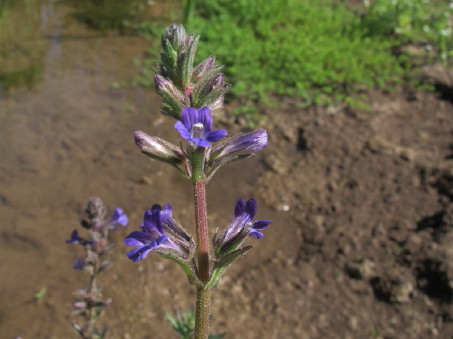Sierra Guadalupe and Sierra Zacatecas — Plants
Here are photos of some of the plants seen on our trip to the Sierra Zacatecas and Sierra Guadalupe west of Mulege, BCS on Nov. 2, 2018. More scenery photos of the region can be found here. The account of our trip is on this page.
Plants are listed A-Z by family, then A-Z by species.
Common names in English and Spanish are noted if available.
Acanthaceae (Acanthus Family)

Ruellia californica subsp. californica. Wild Petunia, Rama Parda, Flor de Campo. The leaves and calyces of this shrub are covered in sticky, glandular hairs that give the plant a distinctive, pungent odor. Plant size: about 1 m H x D.

The flower is showy with many color variations. It ranges from this paler version to the very intense purple of the previous photo. The corolla is about 2.5-3 cm D, the tube 2-3 cm L. It may flower anytime. In dry times, it often may be the only plant in bloom.
Asteraceae (Sunflower Family)

Chloracantha spinosus var. spinosissima. Southern Spiny Aster. Buena mujer. Despite the common Mexican name, this plant is not so "good" because of the firm, sharply pointed stems.

Chloracantha spinosus var. spinosissima. Buena mujer. Heads are 2-2.5 cm D. Great for butterflies and bees. This variety is endemic to wet areas, from s BC southward through most of BCS.
Convolvulaceae (Morning Glory Family)

Mouse Ears, Oreja de Ratón (Evolvulus alsinoides). A native annual found throughout most of BCS.

Mouse Ears (Evolvulus alsinoides). Flowers are about 1 cm D.
Cyperaceae (Sedge Family)

Bent Flatsedge, Junquillo (Eleocharis geniculata).
Fabaceae (Pea Family)

Mexican mimosa, Gatuña (Mimosa distachya var. distachya). This species occurs throughout most of BCS. However, around Mulegé it appears to occur mainly at, or above, 150 m in the sierra foothills.

Leaves are bipinnate. The fruit is a loment and has a firm margin around a number of individual single-seeded segments. When mature, these release from the margin and fall off, leaving clusters of the fibrous margins in place. Two are visible above the dark fruit.
Gratioliaceae (formerly Plantaginaceae)

Water-Hyssop (Bacopa monnieri). A native creeping perennial that is found in many of the wetlands of BCS.

Blue Streamwort (Stemodia durantifolia var. durantifolia). Herbage is glandular. Below is Cyperus laevigatus (Smooth Flatsedge), a species new to me.

Water-Hyssop. Flowers are small, about 7-10 mm D and can be white, pink or bluish.

Blue Streamwort (Stemodia durantifolia var. durantifolia) from Mulegé Ojo, Dec. 2017. Corollas are about 8 mm D and 8-10 mm L.
Phyrmaceae (previously Scrophulariaceae)

Showy Monkeyflower, Mímulo (Erythranthe floribunda). The small plants are usually prostrate to decumbent.

Showy Monkeyflower, Mímulo. This hairy annual has tiny flowers 5-12 mm L with a 3-4 mm D limb.
Polygonaceae (Buckwheat Family)

San Miguelito (Antigonon leptopus). A shrubby, native vine.

San Miguelito (Antigonon leptopus).
Mosses (ID to be determined)

Moss 1 found in dirt along the stream bank.

Moss 3 possibly includes several species at this site, the vertical seep. In this section of the seep, the dirt was "cemented" by minerals from the water and formed a crust.

Moss 4 is the browner lump to the left of Moss 5. Here wetted under the scope at 10-14x

Moss 2 found in crevices in the volcanic bedrock forming part of the stream.

Moss 4 & 5 found in dry dirt below the dry, rocky outcrop. At least two moss species are on the left side and edge of the rock near the bottom of the image, with a dry leaf between them.

Moss 5 from the dry site. This is from the greener mound in the previous photo, and is next to the rock edge. Here wetted under the scope at 10-14x.

Pringle Lip Fern (Myriopteris pringlei var. pringlei). This is a rare fern, known on the peninsula only from the Sierra Guadalupe area (Rebman et. al 2016). It is also found in Sonora, Chihuahua and Arizona.

Myriopteris pringlei var. pringlei leaf.

I had to hydrate my specimen for a few days in order to to reviveit so I could photograph, examine it under a scope and identify it before pressing it.

The inferior side of the leaf, seen at about 10-14 x in scope and camera. The black spots are spores rolled slightly under the leaf margins.
<< Back to Jan 2019 BEE
References:
Rebman, J. P., J. Gibson, and K. Rich, 2016. Annotated checklist of the vascular plants of Baja California, Mexico. Proceedings of the San Diego Society of Natural History, No. 45, 15 November 2016. San Diego Natural History Museum, San Diego, CA.



























